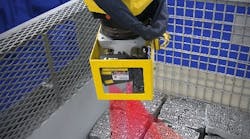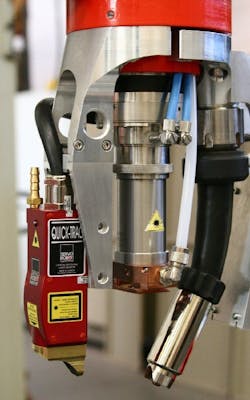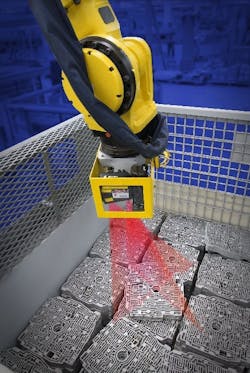Hybrid sensors can simplify and empower robotic applications
Robotic hybrid sensors - those with multiple types of detection systems – aren’t part of the flexible automation mainstream. However, the use of hybrids, while small, is on the rise. More end users of robotic systems believe hybrid sensors have a role in manufacturing. The devices are especially useful for delivering multiple types of part information in robotic manufacturing processes.
|
View related content on PlantServices.com |
A hybrid sensor has “multiple sensors and multiple processing techniques to obtain more information than one could achieve from independent sensors,” says John R. Wright, Jr., associate professor of automation and electronics technologies at the University of Pennsylvania, Millersville. Wright uses a simple equation to describe them: “1+1=3.”
And the survey said...
In the fall of 2006, the Robotic Industries Association (RIA, www.roboticsonline.com), Ann Arbor, Mich., the only North American trade association solely dedicated to robotics, worked with Wright to survey its member companies to explore the potential market for hybrid sensors. The data shows that almost 75% of respondents believe that hybrid sensors would be useful in their plants.
The top three points of interest for hybrid sensors are vision, infrared/laser and photoelectric applications, according to the survey. The survey also asked what benefits deploying hybrid sensors would bring. Adding functionality to a robotic work cell and ease of integration topped the list of perceived benefits.
The greatest potential for hybrid sensors is expected to come from giving vision systems supplemental functionality to undertake applications that are problematical for current vision technology. Nearly 75% of those answering the survey say vision has the most potential to be used in a hybrid sensor system. The survey also found that material handling, assembly, welding and machine tending are applications in which hybrid sensors would be most useful.
Why go hybrid?
There are two reasons that you might consider investing in hybrid sensors for your robotic systems.
“Hybrid sensors can do things that traditional two-dimensional cameras can’t. Two-dimensional cameras can take a picture and send the data to the robot,” says Jeffery Noruk, president of Servo-Robot Corp. (www.servorobot.com). “But, two-dimensional cameras can’t operate under all conditions, such as when lighting changes or depth information changes.” These scenarios are where a hybrid sensor with laser and two-dimensional capabilities would come in handy, Noruk claims.
The second motive Noruk offers for investing in hybrid sensors is related to the limitations of standalone laser vision systems. “Laser vision has a small depth of field and can work only in a relatively small envelope. In a larger envelope, we use an ultrasonic sensor to access a part with precision,” he says.
Hybrid sensors are less expensive in the long run because less equipment can accomplish a range of tasks.
“Justifications for investing in hybrid sensors are the cost-per-performance argument, where hybrid sensors might compete with low-end vision systems, and a pure performance argument, where the addition of other sensory perception combined with existing vision systems might add value for complex applications,” explains Wright.
Hybrid sensor apps
Hybrid sensors are useful for a variety of purposes, including material handling applications. “Hybrid sensors used in material-handling applications combine a camera and an ultrasonic sensor. The ultrasonic sensor gets the gripper to a part at a high speed,” Noruk says. “At a certain distance from the part, the laser sensor, which has a smaller range or depth of field, takes over and guides the robot to the precise location.”
Welding is an application where hybrid sensors could be useful. “One end user deployed a laser system for weld seam tracking using a microphone and a Web camera. The laser sensor is used in real-time robot guidance and the microphone was added for audible confirmation that the process sounds right,” Noruk says. “While the robot is in teach mode, end users have seen the advantages of using hybrid sensors for welding applications.”
Hybrid sensors also are beneficial in pick and place, de-palletizing and auto-racking applications when ultrasonic sensors are combined with laser vision (Figure 1). “Hybrid sensors allow manufacturers to perform some material-handling applications that weren’t possible or efficient before,” says Noruk.
Hybrid sensors have a role in material-handling applications. “Hybrid sensors are used for part location with two-dimensional vision fused with three-dimensional position and orientation information,” says Claude Dinsmoor, general manager for controller product development, FANUC Robotics America (www.fanucrobotics.com).
Using hybrid sensors to locate parts also helps in palletizing and machine loading applications (Figure 2), and in assembly applications, where two-dimensional and three-dimensional vision sensors are used with force sensing for complex assembly, says Dinsmoor. “Hybrid sensors are used for clutch or gear spline assemblies, where neither a person nor a vision system alone can see.”
In packaging applications, hybrid sensors are used for mixed unit palletizing, especially for partial layers as well as finding edges of layers. In sealant and dispensing applications, they can find the location of complex joint and surfaces, such as ditch rail or hem flange areas in automotive manufacturing and for other complex features. Hybrid sensors work in three dimensions and have six degrees of freedom to find locations of parts, and can add a sense of touch with force sensing. “Just looking for the part isn’t good enough,” says Dinsmoor.
“The role of hybrids in material handling, assembly, packaging and dispensing applications may be done today with existing sensors, but it’s a cost/performance competition,” says Wright. “The ease of implementation of hybrid sensors would likely be a secondary benefit for automation professionals who might opt to go with a hybrid.”
Getting hybrids going
Extra sensors are worth the effort of integrating them. “If end users have more than one sensor in a work cell, integrators need to know how to program all the sensor technologies involved,” says Noruk. The same computer and software package handle every sensor in a hybrid system.
“The trick of using hybrid sensors is to allow the user to configure the technology to the desired application,” says Wright. “A major hurdle will be the interface - balancing the power of artificial intelligence with the development of an easy to use, intuitive application software package.”
Not every sensor can be combined with another. “Compatibility is an issue with some optics, because laser sensors have a limited field of view,” Noruk says. If a Web camera is too big, it won’t fit in a work cell. Some compromises among depth of field, field of view and resolution are necessary. “Some hybrid sensors for material handling have a 100-mm field of view. Ultrasonic sensors have a field of view of four meters,” Noruk says. “If the work cell called for a six-meter field of view on an ultrasonic sensor and twice as much on a Web cam, the combination might not work well together.”
Multiple sensors don’t necessarily pay off. “There will be a point of no returns where adding more sensors won’t yield any more significant gains. The number is only limited by cost and performance,” says Wright. Noruk asserts that it’s feasible to add more than three sensors, but he hasn’t seen anyone do it. “I’ve seen three sensors in a material-handling work cell: ultrasonic, laser vision and a Web camera viewer. In a welding application, we’ve combined laser vision with sound and a Web camera,” he says.
Hybrid sensors often are less of a challenge to integrate than a series of external sensors. “If designed as part of the robot, hybrids actually can be simpler and easier to set up and program than conventional sensors. The additional data makes the application more robust and less sensitive to part or environmental variance,” says Dinsmoor. “If the sensors aren’t integrated, they tend to be more complex to design and apply.”
Hybrid future
Hybrid sensors can become the norm in robotic-based manufacturing. Wright expects hybrids will require more investment before they take off in the market. “Hybrid sensors becoming the norm in robotics would depend on the amount of investment that might occur into this research line. I foresee hybrids becoming more commonplace in robotics-based manufacturing within 10 years,” he says.
Dinsmoor sees them going mainstream. “As hybrid sensors become reliable, more applications will use them to add value in robotic-based manufacturing. I think it’ll be three years to five years before hybrid sensors cut across most robotic applications,” he predicts. “Hybrid sensors will make the use of robotics even more attractive over hard automation because reliability and flexibility are key.”
Noruk sees a steady growth of the technology. “Hybrid sensors will creep up in the robotics market rather than explode,” he says. “Hybrid sensors in material handling will grow because some applications can’t be done without them. It took three years to get to 5% of the material handling market. Hybrids won’t be half the market in three years, that’s for sure. It’ll take more success stories about hybrids to get there.”
Bennett Brumson is contributing editor at the Robotic Industries Association in Ann Arbor, Mich. To learn more on how to download the full Material Handling Hybrid Sensor Market Research Report, contact RIA at (734) 994-6088, email Jim Adams ([email protected]), or visit the Association Website at www.roboticsonline.com.


